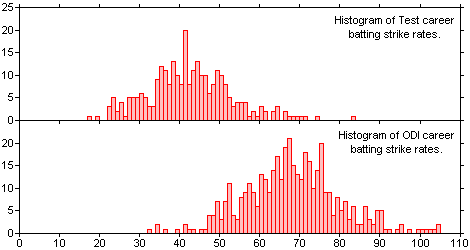Strike rate
This article needs additional citations for verification. (February 2009) |
Strike rate refers to two different statistics in the sport of cricket. Batting strike rate is a measure of how quickly a batsman achieves the primary goal of batting, namely scoring runs. Bowling strike rate is a measure of how quickly a bowler achieves the primary goal of bowling, namely taking wickets (i.e. getting batsmen out).
Both strike rates are relatively new statistics, having only been invented and considered of importance after the introduction of One Day International cricket in the 1970s.[citation needed]
Batting strike rate[]

Batting strike rate (s/r) is defined for a batsman as the average number of runs scored per 100 balls faced. The higher the strike rate, the more effective a batsman is at scoring quickly.
In Test cricket, a batsman's strike rate is of secondary relevance to his ability to score runs without getting out. This means a Test batsman's most important statistic is generally considered to be his batting average, rather than his strike rate.
In limited overs cricket, strike rates are of considerably more importance. Since each team only faces a limited number of balls in an innings, the faster a batsman scores, the more runs his team will be able to accumulate. Strike rates of over 150 are becoming common in Twenty20 cricket.[1] Strike rate is probably considered by most as the key factor in a batsman in one day cricket. Accordingly, the batsmen with the higher strike rate, especially in Twenty20 matches, are more valued than those with a lesser strike rate.
Highest career strike rate (T20I)[]
| Strike rate | Runs scored | Balls faced | Batsman | Team | T20I career span |
|---|---|---|---|---|---|
| 188.35 | 550 | 292 | |
2019–2021 | |
| 165.80 | 577 | 348 | Ravija Sandaruwan |
2019–2020 | |
| 158.92 | 1,780 | 1,120 | Glenn Maxwell |
2012–2021 | |
| 158.52 | 558 | 352 | Tim David |
2019–2020 | |
| 158.03 | 1,318 | 834 | Evin Lewis |
2016–2021 | |
| Qualification: 250 balls. Last updated: 5 September 2021[2] | |||||
Highest career strike rate (ODI)[]
| Strike rate | Runs | Balls faced | Player | Team | Period |
|---|---|---|---|---|---|
| 130.22 | 1,034 | 794 | Andre Russell ‡ | 2011–present | |
| 124.99 | 3,171 | 2,537 | Glenn Maxwell ‡ | 2012–present | |
| 118.66 | 3,872 | 3,263 | Jos Buttler ‡ | 2012–present | |
| 117.31 | 1,267 | 1,080 | Hardik Pandya | 2016–present | |
| 117.06 | 590 | 504 | Lionel Cann | 2006–2009 | |
| Qualification: 500 balls faced. Last updated: 28 March 2021[3] | |||||
Bowling strike rate[]
Bowling strike rate is defined for a bowler as the average number of balls bowled per wicket taken. The lower the strike rate, the more effective a bowler is at taking wickets quickly.
Although introduced as a statistic complementary to the batting strike rate during the ascension of one-day cricket in the 1980s, bowling strike rates are arguably of more importance in Test cricket than One-day Internationals. This is because the primary goal of a bowler in Test cricket is to take wickets, whereas in a one-day match it is often sufficient to bowl economically - giving away as few runs as possible even if this means taking fewer wickets.
Best career strike rate (ODI and T20I)[]
Best career strike rate (Tests)[]
| Strike rate | Player | Country | Balls | Wickets |
|---|---|---|---|---|
| 34.1 | George Lohmann | 3830 | 112 | |
| 37.7 | J. J. Ferris | 2302 | 61 | |
| 38.8 | Shane Bond | 3372 | 87 | |
| 41.7 | Sydney Barnes | 7873 | 189 | |
| 42.3 | Dale Steyn | 18608 | 439 | |
|
Qualification: 2,000 balls | ||||
| Strike rate | Player | Country | Balls | Wickets |
|---|---|---|---|---|
| 30.0 | Duanne Olivier | 1440 | 48 | |
| 33.3 | Kyle Jamieson | 1202 | 36 | |
| 40.8 | Kuldeep Yadav | 1063 | 26 | |
| 41.7 | Kagiso Rabada | 8431 | 202 | |
| 47.1 | Pat Cummins | 7734 | 164 | |
| 48.5 | Anrich Nortje | 1894 | 39 | |
| 48.9 | James Pattinson | 3963 | 81 | |
| 49.0 | Hasan Ali | 2107 | 43 | |
| 49.0 | Jasprit Bumrah | 4075 | 83 | |
| 49.2 | Lungi Ngidi | 1183 | 24 | |
| 49.3 | Mitchell Starc | 12575 | 255 | |
| 49.9 | Mohammad Shami | 8999 | 180 | |
|
Qualification: 1,000 balls | ||||
References[]
- ^ "Records - Twenty20 Internationals - Batting records - Highest career strike rate - ESPN Cricinfo".
- ^ "Records–Twenty20 Internationals–Batting records–Highest career strike rate–ESPN Cricinfo". Cricinfo. ESPN. Retrieved 2 February 2020.
- ^ "Highest strike rate in One Day International cricket". ESPNcricinfo. Archived from the original on 22 June 2019. Retrieved 24 July 2019.
- ^ Jump up to: a b "Test matches – Bowling records – Best career strike rate". Cricinfo. ESPN. Retrieved 26 February 2021.
- Cricket terminology
- Cricket records and statistics
- Rates